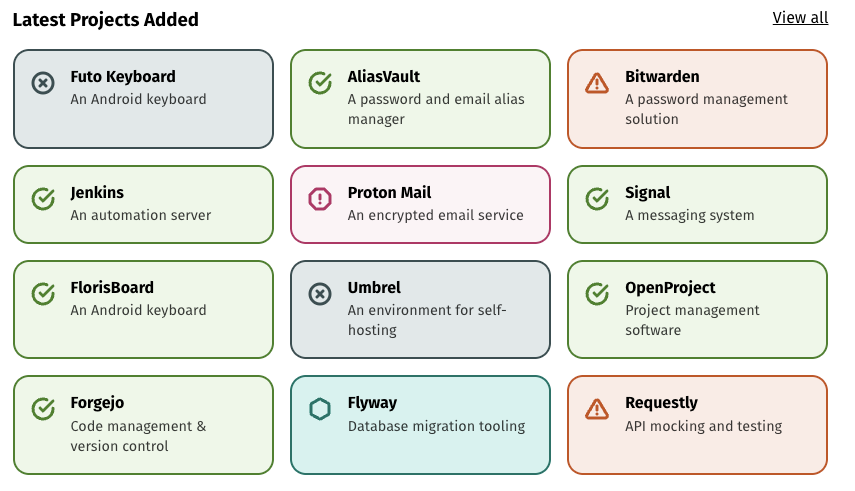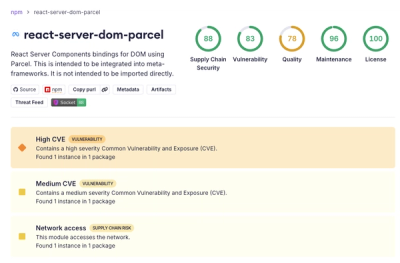
Security News
Deno 2.6 + Socket: Supply Chain Defense In Your CLI
Deno 2.6 introduces deno audit with a new --socket flag that plugs directly into Socket to bring supply chain security checks into the Deno CLI.


Sarah Gooding
August 15, 2025
A new resource, isitreallyfoss.com, has launched to help users determine whether software projects are truly Free and Open Source Software (FOSS) as advertised. Created by UK-based developer Dan Brown, the site is a successor to his earlier Open Source Confusion Cases project, which documented cases of license or “open source” misrepresentation.
While Confusion Cases focused mainly on negative examples and required direct communication with maintainers, this new website takes a more balanced approach. It highlights FOSS-positive projects alongside those with potential problems, removes the requirement for prior outreach before publishing, and presents findings in a more accessible, glanceable format.
The site’s mission is summed up clearly on its homepage:
The software rights of users are continuously (and often opaquely) being eroded by the desire of growth.
This website aims to push back against that by bringing transparency to FOSS software users.
Is It Really FOSS delivers this transparency in a format that is easy to browse, turning complex licensing considerations into clear, digestible insights for both developers and organizations.

Is It Really FOSS? brings greater clarity to the often-murky landscape of Free and Open Source Software. Its mission is threefold: to make the true licensing status of popular projects more transparent for users, to highlight those that exemplify strong FOSS alignment, and to offer constructive advice to projects that want to improve.
Reviews focus on projects that have at some point presented themselves as FOSS, have notable adoption or visibility, and are substantial enough to be considered a product or service rather than a small library. Exceptions are made when a library or smaller project raises significant licensing or transparency concerns. This scope ensures the site’s limited volunteer effort is spent on projects that are influential enough to shape community expectations.

The website allows visitors to filter all 100+ projects by these classifications. It's important to note that these are opinion-based and should be treated as a starting point for deeper due diligence, especially for organizations with compliance requirements.

Two of the most frequent patterns the site calls out are open washing and the limited core model. Open washing happens when a project is promoted as “open source” but the license, feature set, or distribution terms do not meet FOSS definitions. This approach has grown more common as companies try to gain the credibility of an open source label without granting users the freedoms that label implies. Elasticsearch’s license change remains one of the most visible examples, sparking the creation of OpenSearch, but similar situations have unfolded more recently with AI tooling vendors who publish public repositories under non-FOSS licenses while promoting themselves as open source leaders.
The limited core model is another recurring issue. Here, a project makes a minimal “demo” version available as FOSS while keeping the full-featured product proprietary. This can give the impression of a sustainable open source ecosystem, but in reality, users are locked into a proprietary upgrade path to access essential functionality.
Other patterns documented on the site include:
By documenting these patterns, Is It Really FOSS? helps users spot potential problems early before adoption, integration, or compliance issues arise.
In 2025 the open source landscape is more complicated than ever. Companies are experimenting with “delayed open source” licenses, mixing open and proprietary components, and using ambiguous marketing to maintain an open source image while restricting use. For developers, unclear distribution models can mean wasted integration work, unexpected lock-in, or inability to contribute upstream. For organizations, they can trigger compliance violations, particularly in regulated industries where open source usage must be tracked and verified.
Clear, accessible categorization paired with explanations of the risks makes Is It Really FOSS? a useful checkpoint for anyone evaluating software. It is not a legal verdict, but it is an informed lens on transparency, trust, and user rights.
The project is itself FOSS, hosted on Codeberg. Community members can contribute new project entries, request re-reviews, or suggest site improvements. All changes are reviewed for accuracy, and proposals for design or feature changes are discussed to keep the scope focused.
By highlighting good actors and documenting problematic trends, this new website offers a much-needed reality check in an era where the term “open source” is too often stretched to cover distribution models that fall short of guaranteeing user freedoms.
Subscribe to our newsletter
Get notified when we publish new security blog posts!
Try it now

Security News
Deno 2.6 introduces deno audit with a new --socket flag that plugs directly into Socket to bring supply chain security checks into the Deno CLI.

Security News
New DoS and source code exposure bugs in React Server Components and Next.js: what’s affected and how to update safely.

Security News
Socket CEO Feross Aboukhadijeh joins Software Engineering Daily to discuss modern software supply chain attacks and rising AI-driven security risks.